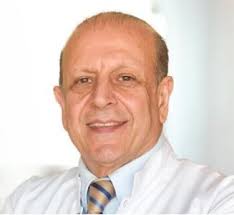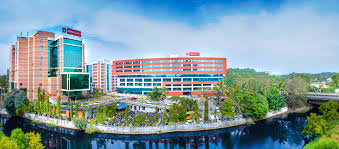Orthopaedic
Excision of Ganglion Treatment
Ganglion Cysts
Ganglion cysts are the mass or lump in the hand. They are non-cancerous and are harmless (in most cases). They occur in various locations, but mostly they develop on the back of the wrist. These fluid-filled cysts can quickly disappear, appear and can change size. Many ganglion cysts often do not require treatment.
Introduction to Excision of Ganglion Cysts
Ganglion cysts are the mass or lump in the hand. They are non-cancerous and are harmless (in most cases). They occur in various locations, but mostly they develop on the back of the wrist. These fluid-filled cysts can quickly disappear, appear and can change size. Many ganglion cysts often do not require treatment. However, if the cyst is painful, interferes with function, or has an unacceptable appearance, there are several options available for treating these cysts.
A ganglion rises out of a joint; it grows out of the tissues surrounding a joint, such as ligaments, tendon sheaths, and joint linings.
Methods of treatment
Ganglion Cysts can be removed either by surgical process or by a non-surgical process
Non-surgical procedures for ganglion cyst removal
Surgery is seen as a last resort for ganglion cyst treatment, but before deciding to remove a ganglion cyst, the patient must go through the other treatment options.
Aspiration
One alternative of removing ganglion cysts other than surgery is having the cyst drained. This occurs through a process called aspiration, in this procedure; the doctor punctures the cyst with the help of a needle and fluid is drained thus causing the cyst to shrink. This can relieve the pain caused by the cyst pressing on the nerves in the patient’s wrist and hand. But because aspiration only drains the cyst and doesn’t remove it, the cyst can grow back after this procedure.
Wrist Brace
The doctor may also prescribe a wrist brace in order to prevent movement around the cyst. Movement can cause the cyst to expand and thus causing more pain and discomfort to the patient. By limiting the movement, a brace can allow the cyst to shrink, which minimizes the pain that is due to cyst pressing the surrounding nerves.
Surgery
There are mainly two ways that surgery can be used to remove a ganglion cyst:
- Open surgery: In this, the surgeon makes a medium-sized cut, generally about 5cm long, over the site of the affected joint or tendon
- Arthroscopic surgery: A type of keyhole surgery where smaller incisions(cut) are made and with the help of a tiny camera called an arthroscope, the surgeon look inside the joint. The surgeon uses the arthroscope as a guide, then they pass the instruments through the incision for the removal of the cyst
Both the techniques can be performed either under local anesthetic, where the patients are awake but will not feel any pain, or general anesthetic, where the patient is asleep during the operation.
Types of Ganglion Cyst Excision
Private Ganglion Cyst Removal
Private ganglion cyst removal is therefore a process of surgically removing a ganglion cyst in a private health care facility such as clinic, hospital or a specialized treatment center. There are several advantages of opting for treatment in private facility; especially in relation to the ease of treatment, customized care and short waiting time.
Arthroscopic Ganglion Cyst Excision
Arthroscopic ganglion cyst excision is a type of surgery in which the cyst is surgically removed without having to make a large incision; the procedure is performed on ganglion cysts near a joint or around the wrist, ankle or knee. Arthroscopy is not an open surgery. It is a minimally invasive surgery that uses a small camera called arthroscope and slight instruments to operate on the affected area. This technique is most favored because of its accuracy, short duration of recuperation, and minimal likelihood of postoperative complications.
Dorsal Ganglion Cyst Excision
Dorsal ganglion cyst excision is a surgical procedure used to remove a cyst that has formed on the dorsal aspect or top surface of a joint, a common region being the wrist. Ganglion cysts are innocuous swellings that develop around joints or tendons filled with a fluid. They may ache, be restrictive to the range of motion of the involved joints or develop into unsightly growths especially when the cysts are found on the dorsum of the wrist.
Need for Excision of Ganglion Treatment
The treatment is used when the cyst becomes painful, uncomfortable, or limits the person’s range of motion.
Here are some common reasons for considering excision of a ganglion:
- Pain or Discomfort
- Interference with Daily Activities
- Cyst Growth or Size
- Recurrent Cysts
Symptoms of Ganglion Cysts:
The lumps associated with ganglion cysts can be distinguished by:
- Location: Ganglion cysts usually develop along the tendons or joints of the wrists or hands. The other common locations are the ankles and feet. These cysts can also occur near other joints.
- Shape and size: Ganglion cysts are round, oval in shape and are usually less than an inch in diameter. Sometimes they are so small that they can't be felt. The size of a cyst can fluctuate, often getting larger when that joint is used for repetitive motions.
- Pain: Ganglion cysts are generally painless. But if a cyst presses on a nerve, even if the cyst is too small to form a noticeable lump, it can results in pain, tingling, numbness or muscle weakness.
What Complications can happen?
As with any surgery, ganglion cyst removal can result in infection. The patient may experience an allergic reaction to the anesthesia, which was used in the removal, or to the stitches used for sealing the removal site.
Other possible risks may include:
- Sensitivity around scar tissue
- Surrounding tendons, nerves, or ligaments may get injured in the process
- The ability to move the wrist normally is lost
- Very often, the patient heals quickly and without any difficulty after a ganglion cyst removal. The rate of recurrence can vary from patient to patient.
Causes
Cause of ganglion cyst is not known exactly but, it grows out of a joint or the lining of a tendon. It looks like a tiny water balloon on a stalk, and it seems to occur when the tissue that surrounds a joint or a tendon bulges out of place. Inside the cyst is a thick lubricating fluid, which is similar to that found in joints or around tendons.
Factors that may increase the risk of ganglion cysts are:
- Sex and age: Ganglion cysts can develop in anyone, but they are common in women who are between 20 and 40.
- Osteoarthritis: People who have wear and tear arthritis in the finger joints closest to their fingernails, have a high risk of developing ganglion cysts near those joints.
- Joint or tendon injury: Joints or tendons that have been injured in the past have high possibility to develop ganglion cysts.
Facilities and Services offered for International Patients for Ganglion Cyst Removal Surgery
It is common for the hospitals and medical centres which are specialized to cater international patients for treatments for instance; excision of a ganglion cyst to offer a range of services which facilitate the ease of experiencing a pleasant encounter.
Here are some typical facilities and services offered for international patients seeking excision of a ganglion cyst:
- Consultation and Pre-Treatment Care
- Surgical Treatment
- Post-Surgical Care and Rehabilitation
- Cost Transparency
- Comfort and Convenience
- Post-Surgery Travel Assistance
Pre-Treatment Process of Excision of Ganglion
The preparations for appointment of the ganglion cyst excision have several steps that precede the treatment and are essential for the correct approaching to the operation. Here’s an overview of the typical pre-treatment process:
- Initial Consultation
- Diagnostic Imaging
- Discussion of Treatment Options
- Blood Tests and Pre-Surgical Screening
- Pre-Surgical Instructions
- Consent and Documentation
- Pre-Surgical Preparation (Day of Surgery)
Diagnostic Tests for Ganglion Cyst Removal Surgery
To achieve precise diagnosis and to determine the characteristics of the cyst as well as surgical procedures several diagnostic tests are made.
Here are the common diagnostic tests for ganglion cysts:
- X-Ray
- MRI
- Aspiration (Cyst Drainage)
- Biopsy
- Blood Tests
Excision of Ganglion Cyst Procedure
- If the doctor decides that surgery is the best option, follow their specific instructions to prepare for surgery.
- Removal of Ganglion cyst is usually an outpatient procedure and may be performed under local or general anaesthesia.
- Before surgery, the doctor may draw a line above the cyst to mark the location where the incision is being made.
- During the surgery, the doctor numbs the treatment area and cuts along the line with a scalpel.
- The doctor then identifies the cyst and cuts it out along with the help of a capsule or stalk.
- Once the cyst is removed, the doctor stitches the opening for the healing of the skin.
Post-Treatment Process of Excision of Ganglion
The care demanded in post-treatment of a ganglion cyst aims at avoiding complications that may accompany the cyst excision and return the affected extremity as a functional limb.
Here’s an overview of the typical steps and recommendations in the post-treatment process:
- Recovery and Immediate Post-Surgery Care
- Managing Pain and Discomfort
- Wound Care and Hygiene
- Follow-up Appointments
- Physical Activity Restrictions
- Diet and Lifestyle Considerations
- Long-Term Care and Outcome
Success Rate of Excision of Ganglion
The reported success rate in ganglion cyst excision is high, since 85-95% of the patients who underwent the procedure are likely to have good prognosis and significant improvement in their symptoms. Recurrence rate is 10-20% and again depends on the tumor type and can be reduced to a reasonable level if there is entire excision.
How soon will I recover?
After the surgery, the patient must rest as much as they can for a few days. This will help the site of the cyst removed to heal quickly. The hand and wrist movement must be minimized to avoid any pain and irritation on the removal site.
The doctor may recommend finger exercises which involves stretching of the fingers and thumb as far out as possible and then bending them as much as is comfortable.
The patient may also experience swelling at the removal site. Swelling can be treated with ice and that will eventually go away with time.
In rarest of cases, the infection may occur after ganglion cyst removal. The doctor may prescribe antibiotics to prevent the infection from further spreading. Keep the dressings and wounds clean for preventing infection and limiting the scarring. Once the surgical site has been healed, the lotion can be applied to ensure that scars have healed properly.
Excision Ganglion Cyst CPT
The excision ganglion cyst cpt (Current Procedural Terminology code) depends on the site of the cyst. Such CPT codes are 25111 for wrist excision, 26160 for tendon sheath or joint capsule removal, and 28090 for foot cyst removal, among others. These codes serve to bring uniformity to billing and documentation processes and yet it is important to clarify procedures with the surgical provider.
Best Hospitals for Excision of Ganglion
- Artemis Hospital, Gurgaon
- Medanta The Medicity
- Fortis Memorial Research Institute, Gurgaon
- Max Hospital, Saket
- BLK-Max Super Speciality Hospital, Delhi
Best Doctors for Excision of Ganglion
- Dr. I P S Oberoi
- Dr. Ashok Rajgopal
- Dr. Jayant Arora
- Dr. Kamal Dureja
- Dr. Pueet Girdhar
Why Choose GetWellGo for Excision of Ganglion?
Some of the advantages for choosing GetWellGo for the ganglion cyst excision includes, being able to access high quality healthcare, professional medical doctors, and safe and efficient healing.
Here’s why GetWellGo could be a great choice for this procedure:
- Expert Medical Team
- Advanced Technology and Facilities
- Comprehensive Patient Services
- High Success Rate and Patient Satisfaction
- Cost-Effective Solutions
- Post-Surgery Care and Rehabilitation
- Patient Education
- Multilingual Support
Conclusion
Surgical excision of ganglionic cysts is a relatively innocuous procedure for symptomatic lesions located in close vicinity to joints or tendons. Asymmetric cryoneurolysis shows 85-95% success rate thus providing immediate pain relief and possible permanent cure. Yet, there are complications and recurrence, but in order to prevent this, it must be subjected to complete excision, as well free post-operation care. The procedure is fast, requires little time of healing and is not likely to give the patient a second bout of the problem. In general, the operation of surgical resection of ganglion cysts is safe and yields good results.
FAQ
1. What are the advantages of a surgical removal of the ganglion cyst?
- Pain Relief: Surgical removal yields a lot of improved pain, inflammation, and suffering arising from the cyst.
- Prevention of Recurrence: If the entire cyst is removed then there is apparently less risk of recurrence of the cysts.
- Improved Functionality: Asymptomatic cysts, however, should be excised due to the likelihood of regaining normal joint or tendon function that could have been compromised due to swelling and stiffening.
- Long-Term Resolution: Close and complete surgical excision can be curative unlike aspiration that can only bring temporary symptomatic improvement.
2. What is its success rate?
- The success rate of ganglion excision however stands at between 85% to 95%. Many patients find a lot of improvement of their condition, and the cyst does not recur after it is properly removed. Nevertheless, if the cyst or the stalk is not removed most of the time or the cyst is large or complex, the risk increases to 10-20%.
3. Which are possible surgical risk factors that decide the success rate of surgery?
- Cyst Size and Location: However, if the cysts are found near these structures such as nerves, tendons, or joints; getting a clean cut may prove difficult.
- Surgical Technique: It is important and advisable for the cyst and its stalk to be totally enucleated so that the rate of recurrence of the cyst is minimized.
- Patient Health: Some patients heal faster and their general condition can affect how successful the surgery will be. There will be some patients who will take longer to recover due to other diseases or complications.
4. Generally, how is the recovery period after excision of a ganglion cyst?
- Initial Recovery: Much like with most surgeries, patient downtime after receiving the physioplasty treatment is low. The first stage of recovery requires 1-2 week with less involvement in activities and focusing on limiting pain.
- Suture Removal: If sutures are used they are generally removed after 7-14 days.
- Full Recovery: Complete healing process entailing ability to return to work and regain movement may take between 4and 6weeks depending on. Extent of surgery and region operated on such a wrist or ankle.
- Physical Therapy: Occasionally, specific exercises may be prescribed by a physician, most often, by a physical therapist and this is because if the ganglion cyst was seated close to a joint then one is likely to need to undertake a course of physiotherapy.
TREATMENT-RELATED QUESTIONS
GetWellGo will provide you end-to-end guidance and assistance and that will include finding relevant and the best doctors for you in India.
A relationship manager from GetWellGo will be assigned to you who will prepare your case, share with multiple doctors and hospitals and get back to you with a treatment plan, cost of treatment and other useful information. The relationship manager will take care of all details related to your visit and successful return & recovery.
Yes, if you wish GetWellGo can assist you in getting your appointments fixed with multiple doctors and hospitals, which will assist you in getting the second opinion and will help you in cost comparison as well.
Yes, our professional medical team will help you in getting the estimated cost for the treatment. The cost as you may be aware depends on the medical condition, the choice of treatment, the type of room opted for etc. All your medical history and essential treatment details would be analyzed by the team of experts in the hospitals. They will also provide you with the various types of rooms/accommodation packages available and you have to make the selection. Charges are likely to vary by the type of room you take.
You have to check with your health insurance provider for the details.
The price that you get from GetWellGo is directly from the hospital, it is also discounted and lowest possible in most cases. We help you in getting the best price possible.
No, we don't charge patients for any service or convenience fee. All healthcare services GetWellGo provide are free of cost.
Top Doctors for Orthopaedic
Top Hospitals for Orthopaedic
Contact Us Now!
Fill the form below to get in touch with our experts.



.jpg)



